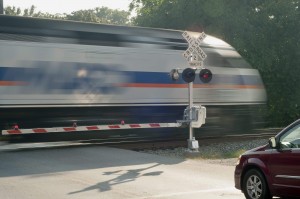
A train passes through the Chestnut Street grade crossing in Gaithersburg, Md. (Tom Fedor/The Gazette)
Eighteen months after a freak railroad accident killed two young people on a trestle in Ellicott City, Md., the stark statistics on railroad deaths morphed into a campaign launched this week to combat them.
“A person or a vehicle is hit by a train every three hours,” said Joyce Rose, whose advocacy group, Operation Lifesaver, has joined railroads and federal transportation officials in a bilingual radio and television campaign intended to educate pedestrians and drivers about the risks they face around railroad tracks.
Two young women, Elizabeth Nass and Rose Mayr, were killed in Ellicott City in 2012 after they climbed up and sat on a train trestle overlooking Main Street as a freight train passed within feet of them. The train derailed, and they were crushed under the weight of spilling coal.
A year later, in 2013, the Federal Railroad Administration (FRA) said 908 pedestrians were injured or killed while walking on or near railroad tracks, an increase of 7.7 percent from 2012. An additional 1,193 people were injured or killed at railroad grade crossings, a 1.5 percent increase.
“The industry is as safe as it’s ever been,” said FRA administrator Joseph Szabo, except for the issue of injury and deaths of people on the tracks or at grade crossings, perhaps because they don’t realize that “it’s going to take more than a mile [for a train] to stop.”
Russ Fletcher, a locomotive engineer for the Kansas City Southern Railroad, said, “I am constantly amazed that people don’t understand the mass and sheer physics. People make poor decisions in a split second that cost them for the rest of their lives.”









